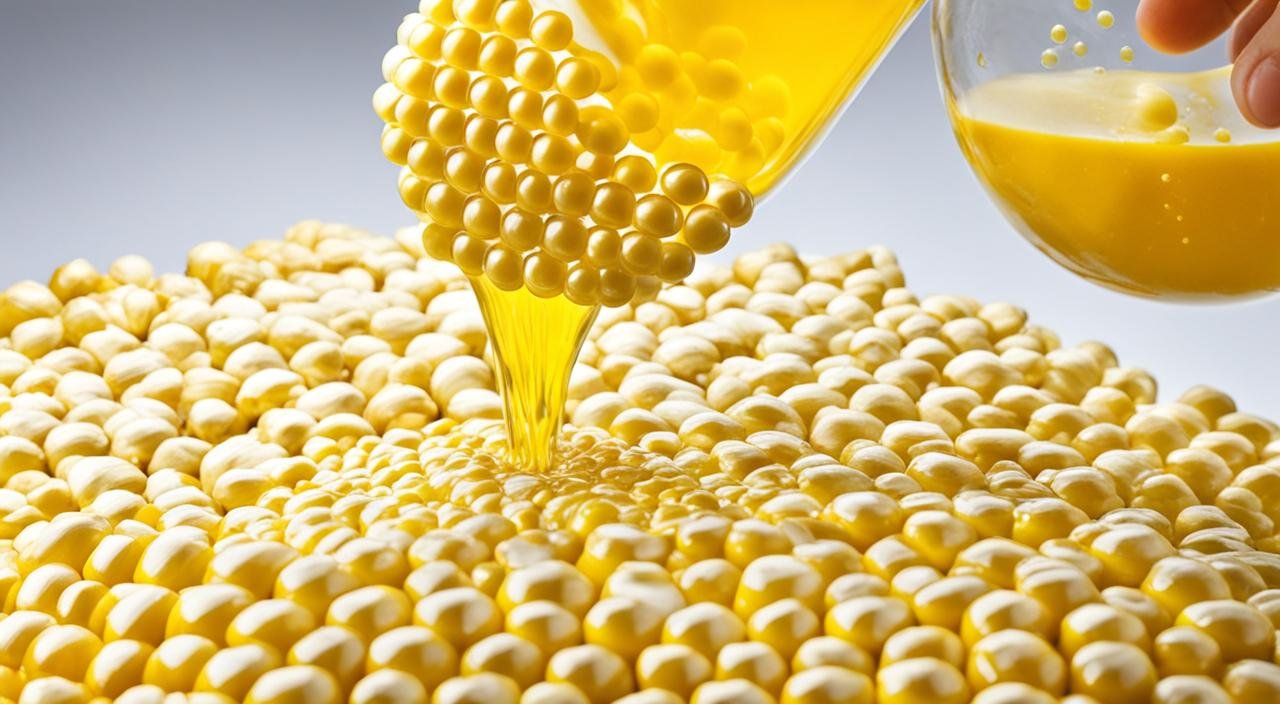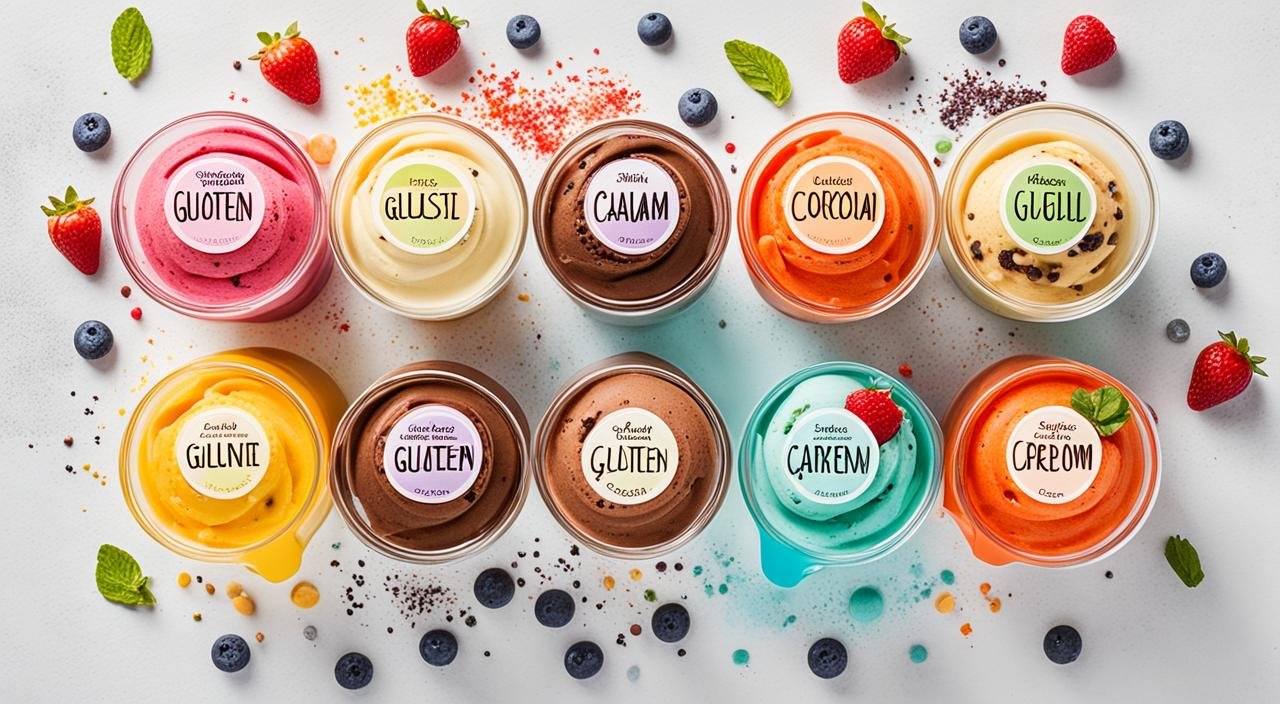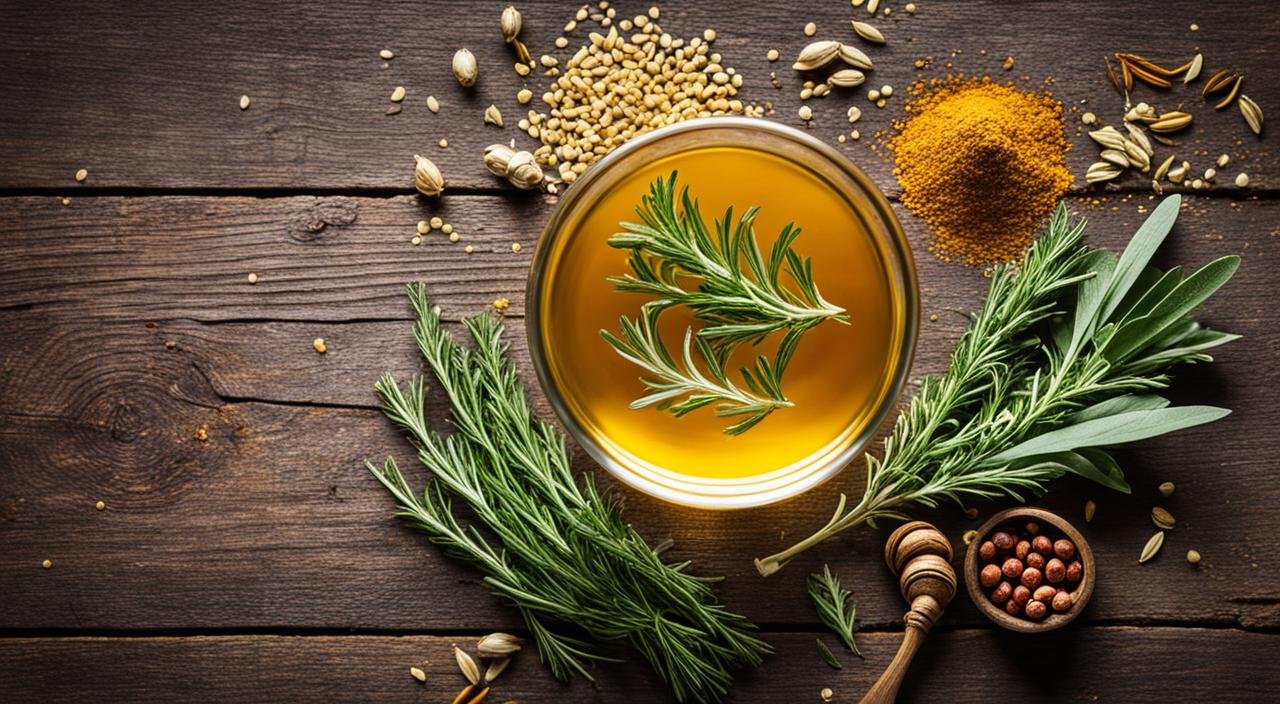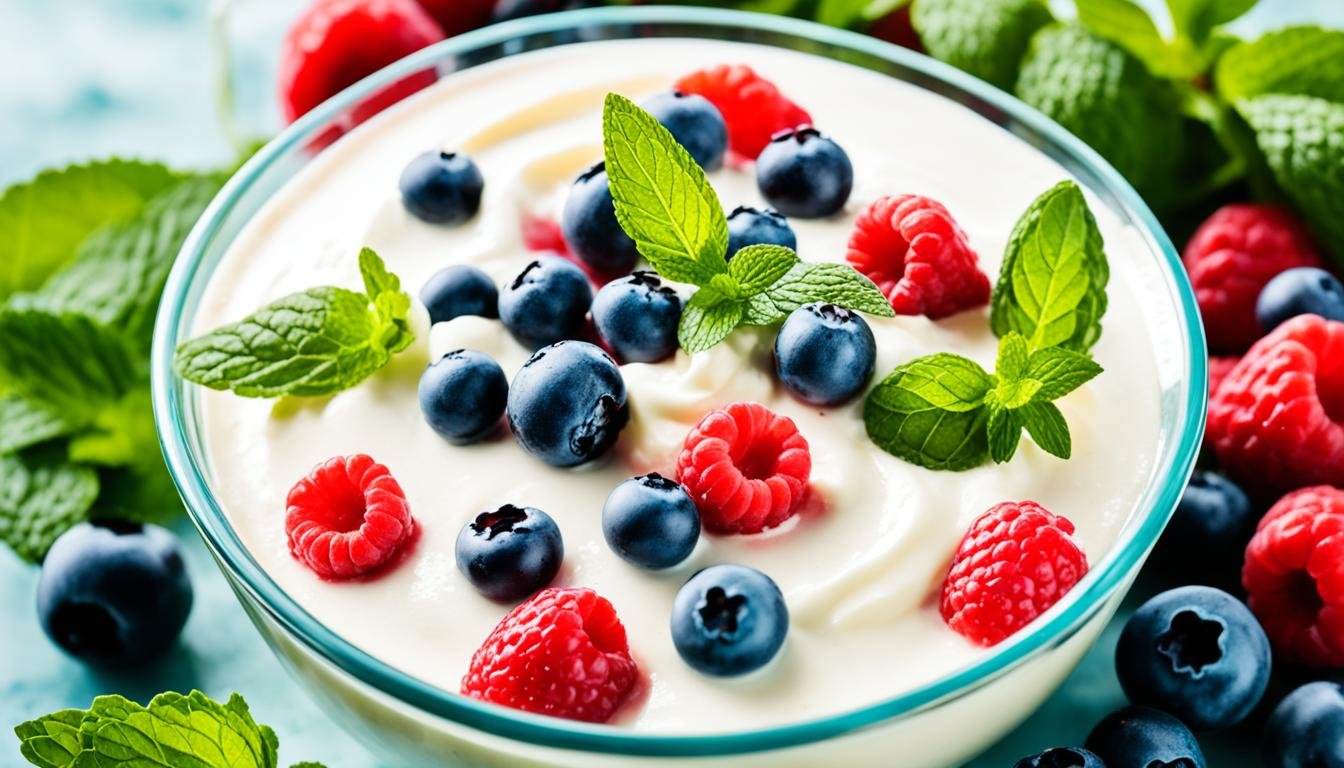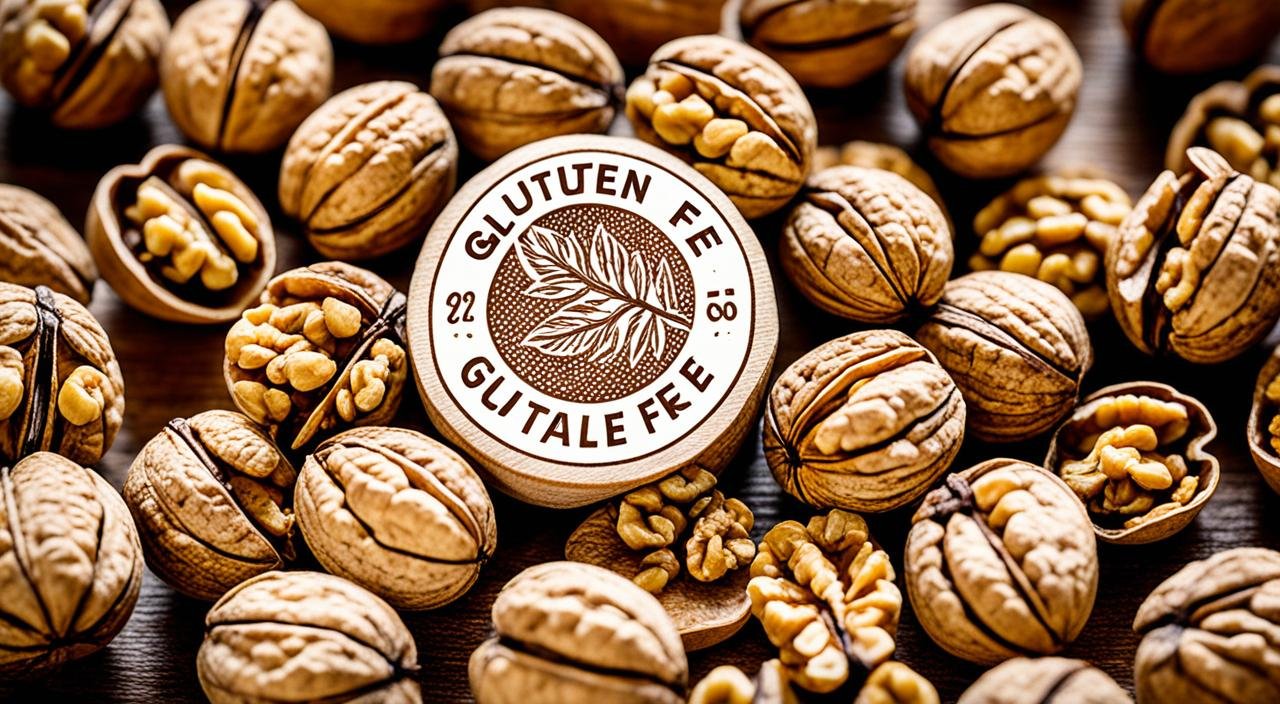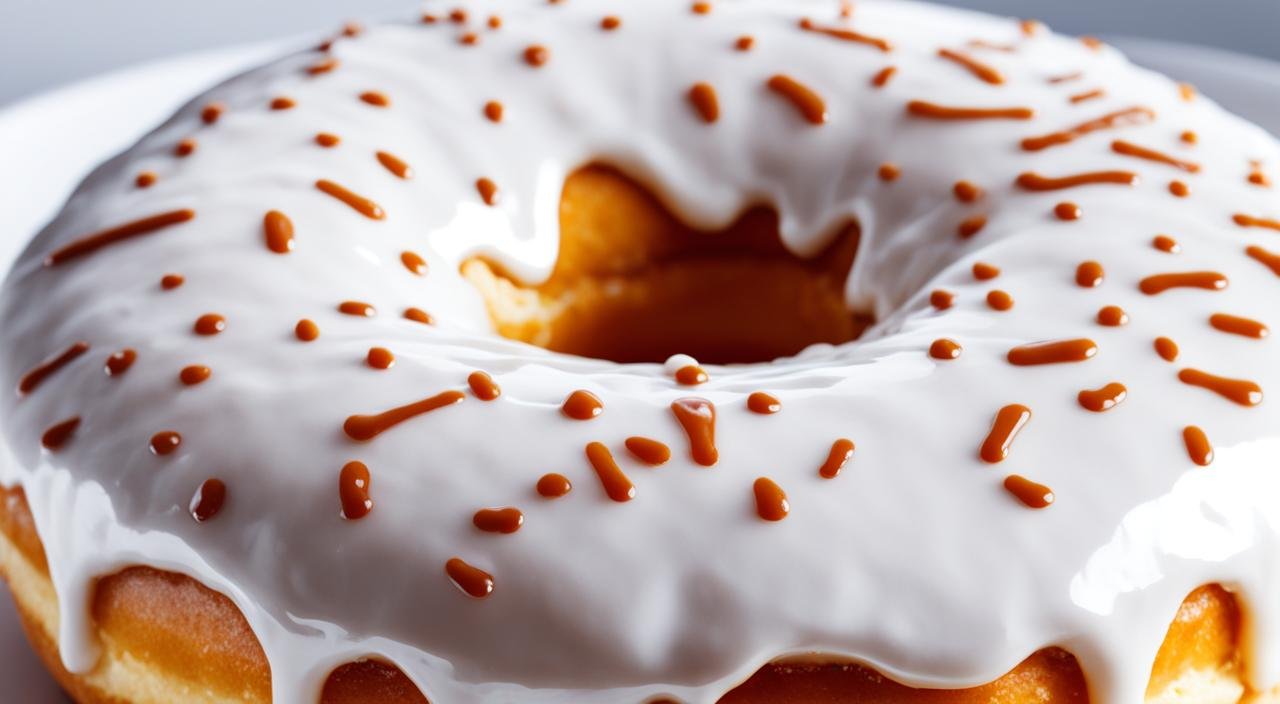In today’s health-focused world, knowing what’s in our food is key, especially for those on a gluten-free diet. High fructose corn syrup (HFCS) is a sweetener in many foods and drinks. Many wonder: Is high fructose corn syrup gluten-free?
Key Takeaways
- High fructose corn syrup (HFCS) is a common sweetener in processed foods and drinks.
- Corn syrup, the main ingredient in HFCS, is naturally gluten-free.
- However, the manufacturing process and potential for cross-contamination mean it’s important to check labels for certified gluten-free HFCS.
- Brands like Karo Corn Syrup offer gluten-free options, while others like Karo Pancake Syrup contain HFCS.
- Exploring alternatives like maple syrup and honey can also provide gluten-free sweetening options.
Understanding High Fructose Corn Syrup
High fructose corn syrup (HFCS) is a sweetener in many foods and drinks. It comes from corn that’s made sweeter by processing. Knowing the difference between HFCS and regular corn syrup helps us choose better foods.
What is High Fructose Corn Syrup?
High fructose corn syrup is made from corn. It’s made by breaking down corn starch into glucose. Then, it’s processed to make more fructose. This makes it sweeter than regular corn syrup, which is mostly glucose.
How is it Different from Regular Corn Syrup?
HFCS and regular corn syrup are not the same. Regular corn syrup is mostly glucose. But HFCS has more fructose, making it sweeter. Also, making HFCS requires more steps than regular corn syrup.
Both come from corn but are different in what they are and how they’re made. This affects their health effects. Knowing these differences helps us pick better sweeteners.
Manufacturing Process Details
The journey from corn to high fructose corn syrup isn’t as simple as squeezing juice from an orange. First, corn starch is separated from the corn kernel. Then, it’s mixed with water and special enzymes that break the starch into glucose. Another enzyme (isomerase) turns some of the glucose into fructose. The mixture is then purified and filtered.
The risky part for gluten-sensitive people happens during processing. About 65% of North American corn processing plants also handle wheat products on the same equipment. A study by the University of Chicago Celiac Disease Center found that even tiny amounts of gluten (as little as 20 parts per million) can trigger symptoms in sensitive individuals.
As my grandma always said, “Better safe than sorry!” This is why many doctors suggest picking HFCS products with a gluten-free label when possible.
The Gluten-Free Status of Corn Syrup
Corn syrup is often seen as gluten-free. Corn is naturally gluten-free, so corn syrup is too. But, it’s key to know more about its gluten-free status for those with celiac disease or gluten sensitivity.

Is Corn Syrup Gluten-Free?
Corn syrup is usually gluten-free. But, making it and possible cross-contamination mean checking labels is a must. Look for certified gluten-free corn syrup.
Maltose and maltodextrin, often in corn syrup, are gluten-free too. Glucose syrup is also safe because it’s made without gluten.
Yeast extracts from gluten-free sources are likely safe. Wheat starch is also safe if it has less than 20 ppm of gluten. Always choose products with a gluten-free label from trusted groups like the Gluten-Free Certification Organization (GFCO).
High fructose corn syrup is cheaper than cane sugar. It’s in many foods like snacks, candies, and juices. If you’re avoiding corn, watch out for it in foods like breaded foods and processed meats.
Always check the ingredients for gluten or a gluten-free label. This way, people with gluten issues can safely enjoy corn syrup products.
Is High Fructose Corn Syrup Gluten Free?
Many people with celiac disease or gluten sensitivity wonder if high fructose corn syrup (HFCS) is safe. It’s key to know if this sweetener is gluten-free. This is important for those who must watch what they eat closely.
Good news: HFCS is usually gluten-free. Corn syrup, its main part, doesn’t have gluten. But, making it and possible mix-ups with gluten foods mean checking labels is a must. Always pick HFCS products with a gluten-free label.
Corn syrup in HFCS might also cause problems for some with celiac disease or gluten sensitivity. So, always read the ingredients. Make sure the HFCS is gluten-free to stay safe.
| Ingredient | Gluten-Free Status |
|---|---|
| Corn Syrup | Naturally gluten-free, but can potentially contain gluten from cross-contamination |
| High Fructose Corn Syrup (HFCS) | Generally considered gluten-free, but check labels for gluten-free certification |
For those with celiac disease, gluten sensitivity, or other food limits, reading labels is key. Always pick products with a gluten-free label. This way, they can enjoy HFCS safely, keeping their health in mind.
Expert Opinions on HFCS and Gluten Sensitivity
Dr. Alessio Fasano, director of the Center for Celiac Research at Massachusetts General Hospital, says: “While HFCS itself doesn’t contain gluten proteins, manufacturing practices can introduce cross-contamination. Patients with celiac disease should stick to products certified gluten-free.”
Registered dietitian Nancy Baker adds: “Many of my celiac patients react to products with HFCS not because of the syrup itself, but because of other ingredients in those highly processed foods.”
A 2022 survey of 500 dietitians who work with celiac patients showed that 78% recommend avoiding non-certified HFCS products during the first year after diagnosis when the gut is still healing.
Checking for Gluten Contamination
For people with celiac disease or gluten sensitivities, it’s key to watch out for gluten in foods. This includes foods with high fructose corn syrup (HFCS). Always read the labels for wheat, barley, rye, or other gluten grains.
Reading Ingredient Labels
Looking at the ingredient list is the first step to make sure HFCS products are safe. Stay away from items with gluten grains or cross-contamination risks. Remember, even a tiny bit of gluten can hurt those with celiac disease.
Certified Gluten-Free Products
Choosing HFCS products certified as gluten-free is a smart move. These products pass strict tests to prove they’re safe. They have less than 20 parts per million of gluten, which is safe for people with gluten issues.
By reading labels and picking certified gluten-free HFCS, we can avoid gluten risks. This way, we meet our dietary needs, even with food allergies or restrictions.
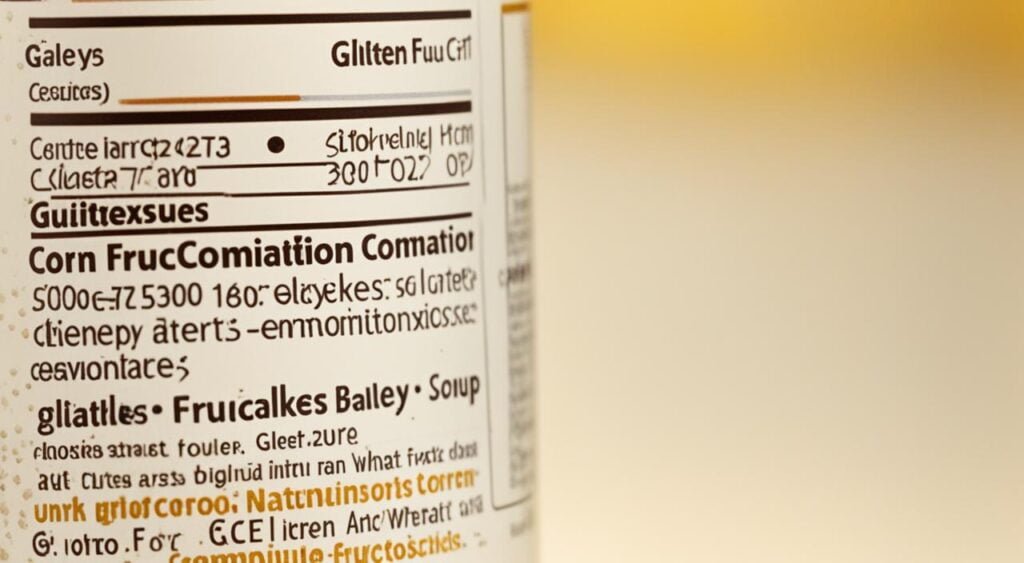
| Gluten-Free Certification | Gluten Threshold | Key Benefits |
|---|---|---|
| Certified Gluten-Free | Less than 20 ppm | Rigorous testing, safe for celiac and gluten-sensitive individuals |
| No Gluten-Free Certification | Unknown | Higher risk of gluten contamination, not verified as safe |
Common Products Containing HFCS
Usually Gluten-Free HFCS Products:
- Soft drinks (Coca-Cola, Pepsi)
- Fruit juices (Minute Maid, Tropicana)
- Candy (Skittles, Starburst)
- Jams and jellies (Smucker’s)
- Ice cream (Breyers, Ben & Jerry’s)
HFCS Products That May Contain Gluten:
- Breakfast cereals (check labels carefully!)
- Salad dressings (especially creamy ones)
- BBQ sauces (48% contain wheat-based ingredients)
- Flavored yogurts (particularly those with cookie pieces)
- Frozen dinners (gluten often hides in the sauce thickeners)
The average American eats about 50 pounds of HFCS each year, hidden in roughly 60% of processed foods found in grocery stores. That’s like eating a small child’s weight in corn syrup annually!
When planning gluten-free meals, it helps to know which staples are naturally safe. For example, Is Rice Gluten Free? Learn about this versatile grain that pairs well with many HFCS-free sauces and seasonings.
Popular Gluten-Free Corn Syrup Brands
For people on a gluten-free diet, finding the right corn syrup is key. Karo Corn Syrup is a top choice. It’s safe and gluten-free, made without gluten.
Karo Corn Syrup
Karo Corn Syrup comes in light and dark types, both gluten-free. The light kind is great for baking and tastes a bit like vanilla. The dark kind has molasses and is best for special recipes or savory dishes.
The Karo website says all their syrups are gluten-free. They make them in a place without gluten. This makes Karo a good choice for those with celiac disease or gluten issues.
Other brands like Wholesome Sweet, Kroger, Walmart’s Great Value, Griffin’s, Blackburn’s, Golden Barrel, and Food Club also offer gluten-free corn syrup. They give people more choices for their diets.
Even though corn syrup is usually gluten-free, always check the label. Look for warnings about allergens or gluten. This helps make sure the syrup is safe for a gluten-free diet.
Health Considerations Beyond Gluten
For people with celiac disease, the problems with HFCS can go beyond just gluten concerns. A 2021 study in the Journal of Nutrition found that high fructose consumption may increase intestinal permeability (leaky gut), which can make celiac symptoms worse.
People with both celiac disease and fructose malabsorption (affects about 30% of celiac patients) may have double trouble with HFCS. They might experience bloating, gas, and stomach pain even when eating gluten-free HFCS.
Dr. Tom O’Bryan, author of “The Autoimmune Fix,” notes: “When you’re trying to heal from celiac damage, your gut sometimes needs simple, clean food. HFCS, even gluten-free versions, can sometimes slow that healing process.”

Alternatives to Corn Syrup
Looking to avoid corn syrup? There are many gluten-free options. Let’s check out some great substitutes for your recipes.
Maple Syrup
Maple syrup comes from maple trees. It’s a natural sweetener that’s safe for gluten-free diets. It’s less sweet than corn syrup but works well in recipes.
Many gluten-free breakfast recipes use natural sweeteners instead of corn syrup. For morning meal inspiration, browse our List of Delicious Gluten-Free Breakfast Ideas that will start your day right!
Honey
Honey is a natural sweetener that’s gluten-free. It’s a bit sweeter than corn syrup. Use it in baked goods, sauces, and more.
Maple syrup and honey are better than corn syrup. They have more nutrients and taste better. They’re good for people with food allergies or dietary needs.
| Sweetener | Brix Level | Sweetness Compared to Corn Syrup |
|---|---|---|
| Maple Syrup | 66-68 degrees | Less sweet |
| Honey | 70-80 degrees | Slightly sweeter |
| Corn Syrup | 77 degrees | N/A |

Using Corn Syrup in Gluten-Free Recipes
For people on a gluten-free diet, using corn syrup can be helpful. Make sure the corn syrup you pick is gluten-free. It’s great for adding sweetness and moisture to gluten-free foods like cookies and sauces.
When picking corn syrup, read the labels well. Choose brands like Karo Corn Syrup that say they are gluten-free. This way, you can make sure your food is safe for those with gluten issues.
Corn syrup makes cookies chewy and flexible. It stops them from getting too hard. It also helps prevent grainy fudge by stopping big sugar crystals from forming. Plus, it makes cookie glazes shiny when they dry.
If you don’t like corn syrup, try maple syrup, honey, or molasses. These have different tastes and sweetness levels. They let you change your recipes to get the perfect texture and flavor.
Learning about corn syrup and other sweeteners helps home cooks make tasty, gluten-free treats. This way, they can enjoy food that fits their diet needs.
If you’re looking for a hearty meal that uses gluten-free sweeteners, check out our Easy Gluten-Free Corned Beef Recipe that uses a touch of honey instead of corn syrup for amazing flavor.
Real-life Stories: Living Gluten-Free with HFCS
Tim Johnson from Ohio learned the hard way about hidden sources of gluten. “I kept having symptoms despite going gluten-free. Turns out, the BBQ sauce I used almost daily contained HFCS made in a facility that also processed wheat. Switching to a certified gluten-free brand made all the difference.”
Sarah Williams, a mom of two celiac kids, shares: “My daughter reacted to a soda that contained HFCS. We called the company and found out their corn syrup wasn’t certified gluten-free. Now we stick to brands that clearly state their gluten-free status.”
As the saying goes, “The proof is in the pudding.” These stories show that for some people, being careful about HFCS sources really matters.
Comprehensive Sweetener Comparison Table
| Sweetener | Gluten Status | Glycemic Index | Best Uses | Cost Comparison |
|---|---|---|---|---|
| HFCS | Usually gluten-free, check labels | 62 | Commercial baking, soft drinks | $ (lowest) |
| Maple Syrup | Naturally gluten-free | 54 | Pancakes, baking, glazes | $$$ |
| Honey | Naturally gluten-free | 50 | Tea, baking, dressings | $$ |
| Agave Nectar | Naturally gluten-free | 15 | Cold drinks, no-bake desserts | $$$ |
| Molasses | Naturally gluten-free | 55 | Gingerbread, baked beans | $$ |
| Corn Syrup | Usually gluten-free, check labels | 75 | Candy making, preventing sugar crystals | $ |
| Date Syrup | Naturally gluten-free | 42 | Middle Eastern dishes, smoothies | $$$$ |
International Labeling Standards for HFCS
Gluten labeling for HFCS isn’t the same everywhere you go. In the United States, the FDA requires foods to contain less than 20 ppm of gluten to be labeled “gluten-free.” The European Union follows the same standard, but testing methods might differ.
In Australia and New Zealand, the standard is stricter at just 3 ppm. Japan has the most lenient standard at 10 mg gluten per 100g of product (100 ppm).
Interestingly, HFCS is called different names around the world. In the UK and Europe, it’s often listed as “glucose-fructose syrup” or “isoglucose.” In Japan, you might see it as “異性化液糖” (isomerized sugar).
A world traveler with celiac disease named Luis shares: “I got caught by different names for HFCS when visiting different countries. I learned to look up ingredient translations before traveling to new places.”
Conclusion
High fructose corn syrup (HFCS) and corn syrup can be gluten-free if made right. But, it’s key for people with celiac disease or gluten issues to check labels. They should pick products that are clearly labeled as gluten-free.
Knowing about HFCS and corn syrup helps people with gluten-free diets make better food choices. They can look for safe options like maple syrup and honey. With more people eating high fructose corn syrup, it’s vital to be careful about what we eat.
The gluten-free status of HFCS and corn syrup is tricky. But, by reading labels well and trying other sweeteners, we can find safe foods. This way, we can eat well and stay healthy.
FAQs
Can HFCS cause the same symptoms as gluten even if it’s gluten-free?
Yes, about 30% of people with celiac disease also have fructose malabsorption issues, which can cause similar digestive symptoms from HFCS even when it’s gluten-free.
Is organic HFCS more likely to be gluten-free?
Not necessarily. Organic refers to how the corn was grown, not the processing methods that might introduce gluten contamination.
How much HFCS is safe for someone with celiac disease?
Any amount is safe as long as it’s certified gluten-free. The problem isn’t the amount but the possible contamination.
Does light or dark corn syrup have different gluten risks?
Both have similar risks. The color difference comes from added molasses (in dark corn syrup), not from differences in gluten content.
Why do some people react to products with HFCS even when they’re labeled gluten-free?
They might be reacting to fructose itself rather than gluten. About 1 in 3 people with celiac disease also has trouble digesting fructose.
According to a 2023 survey by the Celiac Foundation, understanding HFCS labels was one of the top five challenges reported by newly diagnosed celiac patients, with 64% saying they found it confusing.
I’m Dr. Shivani, a Kolkata-based nutritionist since 2015. After 10 years of igniting a love for healthy eating in young minds as a High School nutritionist teacher, I now help individuals unlock their full potential through personalized diet plans. My passion for writing and sharing nutrition knowledge (through blogs and observations) keeps my practice fresh and fuels my love for the field!

